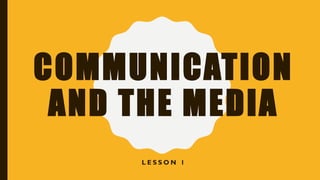
MIL_Lesson 1_Communication.pdf
- 1. COMMUNICATION AND THE MEDIA L E S S O N 1
- 2. At the end of this lesson, you are expected to: A. describe the nature of communication and the concepts related to it; B. identify the different parts of the communication process; C. appreciate the importance of success in communication; D. create a flowchart using the different parts of the communication process.
- 3. • Communication has never been more challenged than in today’s media- saturated world. In the past, people would only tell stories face-to-face. • Nowadays, stories are coursed through electronic and digital means that require a set of communication skills. • Most people Life has never been the same for Filipinos because communication has become complex, but interesting and exciting.
- 4. WHAT IS COMMUNICATION? • Communication is taken from the Latin word commūnicāre, which means “to share” or “to divide out”. • Communication is a process of sharing ideas and opinions about issues, people, events and places between or among persons through various channels to gain common understanding. • It is an interactive process that allows sharing of meanings about texts, images and people’s actions and behavior.
- 5. IN ORDER FOR COMMUNICATION TO TAKE PLACE, TWO MAIN ACTORS WORK TOGETHER • They are called the SENDER and the RECEIVER. • Being able to send the message to a receiver does not guarantee a successful communication process. Effective communication takes place when the sender receives a feedback or response that he initially wanted the receiver to have. • Moreover, the term communication refers to the technical means of communication, or the channel through which messages are conveyed. Mobile phone and computers are part of communications. • Therefore, the process involving people using these technologies is also known as communication.
- 6. THE BASIC TYPES OF COMMUNICATION • Humans communicate through verbal and nonverbal means of relaying information, or through the use of media such as print, broadcast, electronic or new media. • Communication types are defined as the ways by which communication can be expressed. • It can be through verbal communication and nonverbal communication.
- 7. 1. VERBAL COMMUNICATION •communication happens verbally, vocally or through written words expressing or conveying a message, this is known as verbal communication. • Example:When a baby is crying (vocal), this is identified as verbal communication. Hunger pain is expressed vocally.
- 8. TWO TYPES OF VERBAL COMMUNICATION : A. Oral Communication: A communication which happens through word of mouth, spoken words, conversations, and also any messages or information that are shared or exchanged between one another through speech or word of mouth is called oral communication. – Example: public speech, news reading, television, radio, telephone and mobile conversations. B.Written Communication: This is a type of communication that is expressed through written word or often written sign which refers to the languages used in any medium. – Example: simply any hand written, typed, newspaper, printed word documents, letters, books and magazines.
- 9. 2. NONVERBAL COMMUNICATION • Any communication without the use of mouth (voice), spoken words, conversation and written languages is called Nonverbal Communication. It happens through signs, symbols, colors, gestures, body language or any facial expressions.The use of traffic signals is one of the best examples of this type of communication.
- 10. PARTS OF THE COMMUNICATION MODEL a. SOURCE or SENDER – One who sends or delivers a message, and who initiates the communication process. b. MESSAGE – The information or the verbal and nonverbal message conveyed to another person or a group of people. c. MEDIUM – Media is the plural of “medium”, or ways to communicate information. It is also the channel through which the message is coursed. d. RECEIVER – This part of the communication process receives the message.The communication process is considered successful when the receiver responds the way the source intended.
- 11. However, the communication process does not end here.The effect of the message and the feedback of the receiver should also be noted in order to know the result of the communication process.
- 12. PARTS OF THE COMMUNICATION MODEL e. Effect – Response of the receiver after getting the message from the source. f. Feedback – An important product of the communication process. It tells the source how effective the selected message and channel to the receiver. Feedback confirms whether there is mutual understanding between the source and the receiver.
- 13. THE COMMUNICATION PROCESS IS NOT ALWAYS IDEAL. INTERFERENCE CAN OCCUR WHEN THE SOURCE SENDS A MESSAGE. THIS IS CALLED: g. Noise or Barriers – These are the disruptions in the communication process. In the workplace, noise can be common especially when people who are not familiar with each other communicate.
- 14. END…